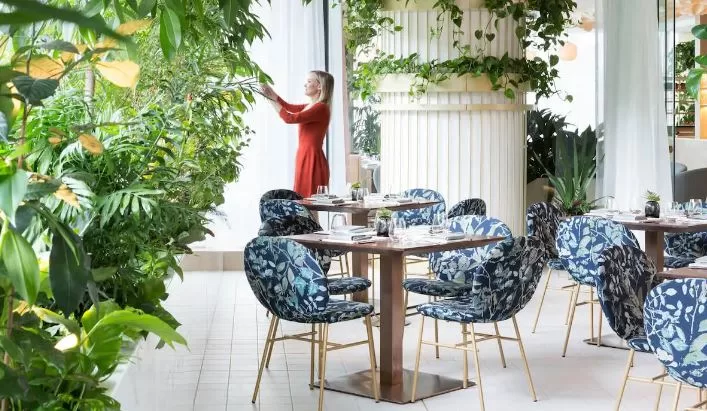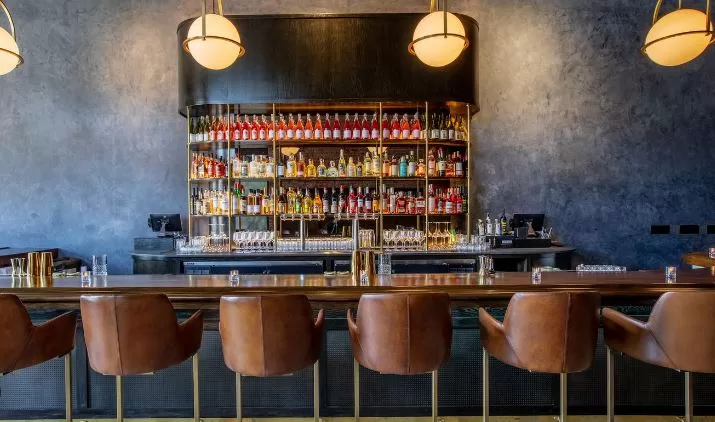Introduction
Designing the interior of a restaurant is a critical aspect of its overall success. A well-thought-out design not only attracts customers but also enhances their dining experience, ultimately contributing to the restaurant’s reputation and profitability. The interior design reflects the restaurant’s concept, cuisine, and target audience, creating a memorable experience that keeps patrons coming back. In this guide, we will explore several key aspects of restaurant interior design, including space layout, furniture, lighting, color schemes, materials, acoustics, and decorative elements. Together, these elements form the foundation for an appealing and functional dining space.

1. Concept and Theme
Every restaurant should have a clear concept or theme that is reflected in its interior design. Whether the restaurant is casual, fine dining, or themed (such as a Mexican or Italian restaurant), the interior must echo this concept. The design should complement the menu, service style, and overall branding. For example, a seafood restaurant may have a nautical theme, incorporating blues, whites, and wooden textures, while an urban café might feature industrial elements like exposed brick and metal fixtures. The theme must be consistent throughout all aspects of the design, from the seating arrangements to the wall art and even the cutlery, creating a cohesive and immersive dining experience.

2. Space Layout and Flow
-
Efficient use of space is one of the most important elements in restaurant design. The layout should ensure that both customers and staff can move freely without feeling cramped. This includes thoughtful spacing between tables, easy access to restrooms, and smooth circulation paths for servers and kitchen staff. In many cases, an open floor plan can enhance the atmosphere, creating a more social and airy environment. However, in more intimate or upscale settings, privacy may be preferred, so the design should incorporate partitioned areas or booth seating.
The layout must also account for the kitchen, storage, and service areas. These spaces should be strategically located to minimize disruption to the dining experience. A well-planned layout optimizes workflow, helping the restaurant operate efficiently during busy hours while also providing customers with a comfortable, stress-free dining experience.

3. Furniture
-
Choosing the right furniture is crucial to both the aesthetic appeal and comfort of the restaurant. The furniture should match the overall theme of the restaurant while also being practical and durable. For instance, a high-end restaurant may opt for upholstered chairs and tables with polished wooden finishes, while a casual diner might use metal chairs and rustic wooden tables.
The seating should also cater to different group sizes, providing options for couples, small groups, and larger parties. Booths are a popular choice for diners seeking a more private experience, while communal tables can foster a lively, social atmosphere. When selecting furniture, it’s important to consider not only style but also durability, ease of cleaning, and comfort, as patrons are likely to spend extended periods sitting and dining.

4. Lighting
-
Lighting plays a critical role in setting the mood and tone of a restaurant. The right lighting can enhance the ambiance, making the space feel inviting and cozy or sleek and sophisticated. Natural light, if available, should be maximized during daytime hours. Large windows or skylights can provide beautiful, soft lighting that enhances the dining experience.
In the evening, artificial lighting takes center stage. Warm, soft lighting creates an intimate and relaxing atmosphere, ideal for romantic dinners or fine dining establishments. On the other hand, bright lighting works better for fast-casual and family-oriented restaurants. It’s also important to layer lighting with a combination of ambient, task, and accent lighting to create depth and highlight specific areas like the bar, artwork, or architectural features.
Lighting fixtures themselves can also be statement pieces, serving as an extension of the restaurant’s design theme. Chandeliers, pendant lights, or modern industrial fixtures can add personality to the space and reinforce the restaurant’s concept.

5. Color Scheme
- The choice of colors in a restaurant’s interior design is more than just a decorative decision; it affects the mood, energy, and appetite of customers. Warm colors such as reds, oranges, and yellows are known to stimulate appetite and create a lively, energetic atmosphere. This makes them suitable for fast food outlets or family-style restaurants. On the other hand, cooler colors like blues, greens, and purples can create a more tranquil and refined ambiance, which is more appropriate for upscale dining.
Neutral tones like beige, gray, or taupe are often used as a base, allowing the accent colors to stand out and creating a balanced palette. Bold color choices can be introduced through furniture, artwork, or wall treatments, but they should be used sparingly to avoid overwhelming the space.

5. Color Scheme
- The choice of colors in a restaurant’s interior design is more than just a decorative decision; it affects the mood, energy, and appetite of customers. Warm colors such as reds, oranges, and yellows are known to stimulate appetite and create a lively, energetic atmosphere. This makes them suitable for fast food outlets or family-style restaurants. On the other hand, cooler colors like blues, greens, and purples can create a more tranquil and refined ambiance, which is more appropriate for upscale dining.
Neutral tones like beige, gray, or taupe are often used as a base, allowing the accent colors to stand out and creating a balanced palette. Bold color choices can be introduced through furniture, artwork, or wall treatments, but they should be used sparingly to avoid overwhelming the space.

6. Materials and Finishes
The materials used in a restaurant’s interior affect both its aesthetics and functionality. For example, wood adds warmth and a sense of natural beauty, while metal and glass can lend a modern, industrial feel. The choice of materials should align with the restaurant’s theme and be durable enough to withstand heavy traffic and regular cleaning.
Flooring is an important consideration, as it needs to be both visually appealing and functional. Hardwood, tile, and concrete are common choices, but the decision will depend on factors like budget, maintenance, and the desired look. Wall finishes, such as paint, wallpaper, or exposed brick, also contribute to the restaurant’s character.
In some cases, acoustic treatments may be necessary to control noise levels. Restaurants can be loud, especially during peak hours, and materials like carpets, curtains, and acoustic panels can help reduce the echo and make conversations more comfortable.

6. Materials and Finishes
The materials used in a restaurant’s interior affect both its aesthetics and functionality. For example, wood adds warmth and a sense of natural beauty, while metal and glass can lend a modern, industrial feel. The choice of materials should align with the restaurant’s theme and be durable enough to withstand heavy traffic and regular cleaning.
Flooring is an important consideration, as it needs to be both visually appealing and functional. Hardwood, tile, and concrete are common choices, but the decision will depend on factors like budget, maintenance, and the desired look. Wall finishes, such as paint, wallpaper, or exposed brick, also contribute to the restaurant’s character.
In some cases, acoustic treatments may be necessary to control noise levels. Restaurants can be loud, especially during peak hours, and materials like carpets, curtains, and acoustic panels can help reduce the echo and make conversations more comfortable.

7. Acoustics and Noise Management
A restaurant’s acoustic environment greatly influences the customer experience. Loud, noisy environments can make conversations difficult and detract from the dining experience, while overly quiet spaces can feel awkward or uncomfortable. Finding the right balance is key, and acoustics should be carefully managed, especially in larger or busier restaurants.
Acoustic treatments can include sound-absorbing materials like upholstered furniture, carpets, curtains, or acoustic ceiling tiles. These materials help to soften sound and reduce noise levels, ensuring that the restaurant remains a pleasant environment even when it’s busy.
Background music can also enhance the atmosphere, but it needs to be in harmony with the restaurant’s concept. Soft jazz or classical music might be appropriate for a fine dining setting, while a casual café might play upbeat indie tunes.

8. Decorative Elements and Art
Decorative elements, such as artwork, plants, mirrors, and sculptures, add personality and charm to a restaurant. These items should reflect the restaurant’s theme and be used to create focal points or enhance the visual interest of the space. For example, a restaurant that focuses on local cuisine might feature artwork from local artists or display regional artifacts.
Mirrors can be used strategically to make a space feel larger and brighter, while greenery adds a touch of nature and liveliness. However, the decor should not be overwhelming or cluttered; simplicity often has a stronger visual impact.

9. Bar and Counter Design
If the restaurant has a bar, its design should seamlessly integrate with the rest of the interior while serving as a focal point. The bar can be a social hub, so it should be visually appealing and comfortable for patrons. Materials such as marble, granite, or wood are commonly used for bar countertops, while stools should be comfortable and stylish.

10. Branding and Signage
Lastly, the restaurant’s branding should be subtly incorporated into the interior design. This includes the use of the restaurant’s logo, color palette, and typography in signage, menus, and even the uniforms of the staff. Branding should be consistent throughout the space, reinforcing the restaurant’s identity and making it instantly recognizable.

conclusion
In conclusion, a well-designed restaurant interior is a fusion of aesthetics, functionality, and atmosphere. From the layout and furniture to lighting and acoustics, every detail plays a part in creating a memorable dining experience. By aligning the interior design with the restaurant’s concept and ensuring comfort and visual appeal, restaurateurs can create an environment that not only attracts customers but also encourages them to return.
About Author sudeshna mukherjee
You May Also Like…
The Ultimate Guide to Hiring a Consultant Chef
Introduction Food trucks or mobile food trucks is an idea that has arrived. But, there is a issues with food safety in...
Food Safety Essentials: Addressing 5 Common Problems in Food Trucks
Introduction Food trucks or mobile food trucks is an idea that has arrived. But, there is a issues with food safety in...



